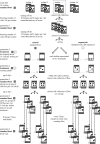Rapamycin supplementation of Drosophila melanogaster larvae results in less viable adults with smaller cells
- PMID: 37351490
- PMCID: PMC10282583
- DOI: 10.1098/rsos.230080
Rapamycin supplementation of Drosophila melanogaster larvae results in less viable adults with smaller cells
Abstract
The intrinsic sources of mortality relate to the ability to meet the metabolic demands of tissue maintenance and repair, ultimately shaping ageing patterns. Anti-ageing mechanisms compete for resources with other functions, including those involved in maintaining functional plasma membranes. Consequently, organisms with smaller cells and more plasma membranes should devote more resources to membrane maintenance, leading to accelerated intrinsic mortality and ageing. To investigate this unexplored trade-off, we reared Drosophila melanogaster larvae on food with or without rapamycin (a TOR pathway inhibitor) to produce small- and large-celled adult flies, respectively, and measured their mortality rates. Males showed higher mortality than females. As expected, small-celled flies (rapamycin) showed higher mortality than their large-celled counterparts (control), but only in early adulthood. Contrary to predictions, the median lifespan was similar between the groups. Rapamycin administered to adults prolongs life; thus, the known direct physiological effects of rapamycin cannot explain our results. Instead, we invoke indirect effects of rapamycin, manifested as reduced cell size, as a driver of increased early mortality. We conclude that cell size differences between organisms and the associated burdens of plasma membrane maintenance costs may be important but overlooked factors influencing mortality patterns in nature.
Keywords: TOR; ageing; cell size; life history; mortality; survivorship.
© 2023 The Authors.
Conflict of interest statement
We declare that we have no competing interests.
Figures






Similar articles
-
Thermal and Oxygen Flight Sensitivity in Ageing Drosophila melanogaster Flies: Links to Rapamycin-Induced Cell Size Changes.Biology (Basel). 2021 Sep 2;10(9):861. doi: 10.3390/biology10090861. Biology (Basel). 2021. PMID: 34571738 Free PMC article.
-
Are invertebrates relevant models in ageing research? Focus on the effects of rapamycin on TOR.Mech Ageing Dev. 2016 Jan;153:22-9. doi: 10.1016/j.mad.2015.12.004. Epub 2016 Jan 4. Mech Ageing Dev. 2016. PMID: 26763146 Review.
-
Temperature dependent larval resource allocation shaping adult body size in Drosophila melanogaster.J Evol Biol. 2003 Nov;16(6):1159-67. doi: 10.1046/j.1420-9101.2003.00621.x. J Evol Biol. 2003. PMID: 14640407
-
Drosophila larvae lacking the bcl-2 gene, buffy, are sensitive to nutrient stress, maintain increased basal target of rapamycin (Tor) signaling and exhibit characteristics of altered basal energy metabolism.BMC Biol. 2012 Jul 24;10:63. doi: 10.1186/1741-7007-10-63. BMC Biol. 2012. PMID: 22824239 Free PMC article.
-
Ageing in Drosophila: the role of the insulin/Igf and TOR signalling network.Exp Gerontol. 2011 May;46(5):376-81. doi: 10.1016/j.exger.2010.09.003. Epub 2010 Sep 16. Exp Gerontol. 2011. PMID: 20849947 Free PMC article. Review.
Cited by
-
Heat tolerance in Drosophila melanogaster is influenced by oxygen conditions and mutations in cell size control pathways.Philos Trans R Soc Lond B Biol Sci. 2024 Feb 26;379(1896):20220490. doi: 10.1098/rstb.2022.0490. Epub 2024 Jan 8. Philos Trans R Soc Lond B Biol Sci. 2024. PMID: 38186282 Free PMC article.
References
-
- Ricklefs RE. 2008. The evolution of senescence from a comparative perspective. Evol. Ecol. Senescence 22, 379-392. (10.1111/j.1365-2435.2008.01420.x) - DOI
Associated data
LinkOut - more resources
Full Text Sources
Molecular Biology Databases
Research Materials

